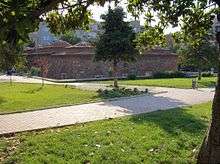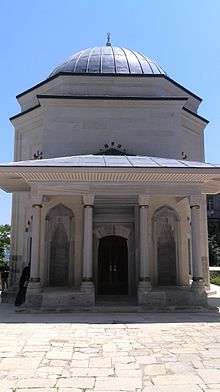Hafsa Sultan
Hafsa Sultan (Ottoman Turkish: حفصه سلطان; c. 1478 – March 1534) was the wife of Selim I and the first valide sultan of the Ottoman Empire as the mother of Suleiman the Magnificent. During the period between her son's enthronement in 1520 and her death in 1534, she was one of the most influential persons in the Ottoman Empire.[6]
| Hafsa Sultan | |
|---|---|
 | |
| Valide Sultan of the Ottoman Empire | |
| Tenure | 30 September 1520 – 19 March 1534 |
| Predecessor | Gülbahar Hatun (as Valide Hatun) |
| Successor | Nurbanu Sultan |
| Born | c. 1478[1] |
| Died | March 1534 (aged 55–56)[2] Istanbul, Ottoman Empire |
| Burial | |
| Spouse | Selim I |
| Issue | Suleiman the Magnificent Hatice Sultan Fatma Sultan |
| Father | Disputed. Meñli I Giray[3] or Abd'ûl-Muin[4][5] or Abdulhay[5] |
Origins
The traditional view holding that Hafsa Sultan was the daughter of Meñli I Giray (1445–1515), the khan of the Crimean Tatars for much of the period between 1466 and 1515, resting on seventeenth century western authors accounts, has been challenged in favor of a Christian slave origin based on Ottoman documentary evidence.[7][8] Several historians still follow the traditional view though, including Brian Glyn Williams.[3] Reşat Kasaba mentions the marriage between Selim I and Hafsa Sultan as the "last marriage between an Ottoman sultan and a member of a neighboring Muslim royal family".[9] Esin Atıl, however, states that whilst some historians state that she was the daughter of Giray, others have mentioned that the Crimean princess named "Ayse" was another one of Selim I's wives and that "Hafsa" may have been of slave origin.[5] Ilya Zaytsev claims that "Ayshe (daughter of Mengli-Giray I)" first married Şehzade Mehmed, the governor of Kefe, and that she later married his brother Selim I; consequently, her marriage into the Ottoman dynasty was one of two noted instances of wedlock between the Girays and the Ottomans (the other being the marriage of Selim I's daughter to Saadet-Giray).[10] Alan W. Fisher, Leslie Peirce, and Feridun Emecen all see Hafsa as of slave origin and not the daughter of the Crimean Khan.[11]
Life

Having resided in the city of Manisa in western Turkey with her son, Suleiman, who administered the surrounding region between 1513 and 1520 (the town functioned as one of the traditional residences for Ottoman crown princes (şehzade) in apprenticeship for future power), Hafsa Sultan initiated the Manisa's "Mesir Festival", a local tradition continued today. She also had a large complex built in the city consisting of a mosque known as the Sultan Mosque, a primary school, a college, and a hospice.
She was also the first Ottoman imperial women who held title "sultan" after her given name, replacing title "hatun". This usage reflected the Ottoman conception of sovereign power as "family prerogative".[12] Consequently, the title valide hatun (title for living mother of the reigning Ottoman sultan before 16th century) also turned into valide sultan, making Hafsa the first valide sultan. Her era signalled the shifting status of the sultan's mother and her increased share in power.[13] She was also the first harem woman confirmed to have a kira - Strongilah.[14]
Death

Hafsa Sultan died in March 1534 and was buried near her husband in a mausoleum behind the qiblah wall of Yavuz Selim Mosque, in Fatih, Istanbul. The mausoleum was largely destroyed in an earthquake in 1884, a reconstruction effort started in the 1900s (decade) having been left discontinued, and her tomb today is much simpler than it was built originally.
References
- Sakaoğlu, Necdet (2008). Bu mülkün kadın sultanları: Vâlide sultanlar, hâtunlar, hasekiler, kadınefendiler, sultanefendiler. Oğlak Yayıncılık. p. 199. ISBN 978-9-753-29623-6.
- Peirce, Leslie P. (1993). The Imperial Harem: Women and Sovereignty in the Ottoman Empire. Oxford University Press. p. 121. ISBN 0-19-508677-5.
- Glyn Williams, Brian (2001), The Crimean Tatars: The Diaspora Experience and the Forging of a Nation, BRILL, p. 56, ISBN 0295801492,
Ottoman princes, such as the future Ottoman Sultans Selim I (who married Mengli Giray Khan's daughter, Hafsa Hatun...
- Sakaoğlu, Necdet (2008). Bu mülkün kadın sultanları: Vâlide sultanlar, hâtunlar, hasekiler, kadınefendiler, sultanefendiler. Oğlak Yayıncılık. p. 148. ISBN 978-9-753-29623-6. (Her name is given as "Hafsa bint-i Abdü'l-Muin" in Kitâbeler by İ. H. Uzunçarşılı. This shows that she was of non-Turkish origin, and later converted to Islam.)
- Atıl, Esin (1987), The Age of Sultan Süleyman the Magnificent, National Gallery of Art, p. 27, ISBN 0810918552,
Some historians state that she was the daughter of Mengili Giray Han, the ruler of the Crimean Tatars. Others mention that Ayse, another wife of Selim I, was the Crimean princess and give as Hafsa's father a man named Abdulmumin or Abdulhay, and unknown person - suggesting that she was of slave origin.
- Pietro Bragadin, Venetian Republic's ambassador in the early years of Suleiman the Magnificent's reign notes "a very beautiful woman of 48, for whom the sultan bears great reverence and love..." Peirce, Leslie (1993). The Imperial Harem : Women and Sovereignty in the Ottoman Empire. Oxford University Press. p. 62. ISBN 0-19-508677-5.
- Alan Fisher (1993). "The Life and Family of Suleyman I". In İnalcık, Halil; Kafadar, Cemal (eds.). Süleymân The Second [i.e. the First] and his time. Isis Press.
That she was a Tatar, a daughter of the Crimean Khan Mengli Giray, was a story apparently begun by Jovius, repeated by other western sources, and taken up by Merriman in his biography of Suleyman
- Encyclopedia of Islam vol. IX (1997), s.v. Suleyman p.833
- Kasaba, Resat (2011), A Moveable Empire: Ottoman Nomads, Migrants, and Refugees, University of Washington Press, p. 44, ISBN 0295801492,
The last marriage between an Ottoman sultan and a member of a neighboring Muslim royal family was the one between Selim I and Hafsa Sultan, the daughter of the Crimean ruler Mengli Giray Khan.
- Zaytsev, Ilya (2006), "The Structure of the Giray Dynasty (15th-16th centuries): Matrimonial and Kinship Relations of the Crimean Khans", Kinship in the Altaic World: Proceedings of the 48th Permanent International Altaistic Conference, Moscow 10-15 July 2005, Otto Harrassowitz Verlag, p. 341, ISBN 3447054166,
Only two instances concerning the Ottomans are noted. Ayshe (daughter of Mengli-Giray I) was married to şehzade and governor of Kefe Mehmed, and to his brother Selim I later on (917/1511). Sultan Selim's daughter was married to Saadet-Giray.
-
- Alan Fisher (1993). "The Life and Family of Süleymân I". In İnalcık, Halil; Cemal Kafadar (eds.). Süleymân The Second [i.e. the First] and His Time. Istanbul: Isis Press. p. 9. ISBN 975-428-052-5.
- Emecen, Feridun (2010). "Süleyman I". İslâm Ansiklopedisi. 38. İslâm Araştırmaları Merkezi. pp. 62–74.
Information indicating that she was the daughter of the Crimean Khan or was related to the family of Dulkadıroğlu is incorrect.
- Peirce, Leslie (1993). The Imperial Harem: Women and Sovereignty in the Ottoman Empire. Oxford University Press. pp. 40. ISBN 0-19-508677-5.
- Peirce, Leslie P. (1993). The Imperial Harem: Women and Sovereignty in the Ottoman Empire. Oxford University Press. ISBN 0-19-508677-5.
- Amy Singer (2002). Constructing Ottoman beneficence: An imperial soup kitchen in Jerusalem. State University of New York Press. p. 90. ISBN 0-7914-5351-0.
- Minna Rozen: A History of the Jewish Community in Istanbul, The Formative Years, 1453 – 1566 (2002).
External links
| Wikimedia Commons has media related to Hafsa Sultan. |
- "Hafsa Sultan Complex". Archnet. 2005.
| Ottoman royalty | ||
|---|---|---|
| Preceded by Gülbahar Hatun as Valide Hatun |
Valide Sultan 30 September 1520 – 19 March 1534 |
Succeeded by Nurbanu Sultan |
